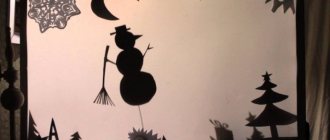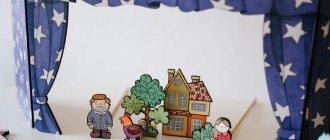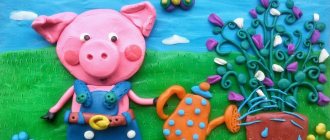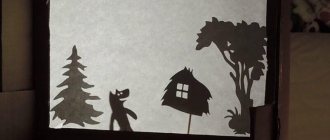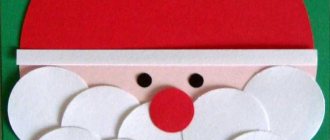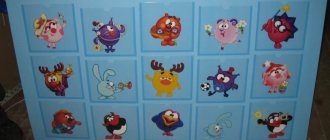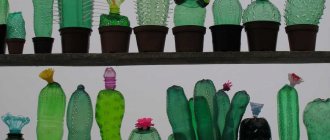Types of puppet theaters and materials
Any parent can create their own home theater. You can also involve a child in this matter. Surely in this case the process will be more fun, and the baby will be busy.
For work, something that many people will definitely have at home is suitable. Even some waste materials will come in handy, so don’t rush to scrap them.
It could be:
- Disposable plastic tableware,
- Felt,
- Boxes of different shapes and sizes,
- Colored paper/cardboard,
- Rolls of paper towels, foil or toilet paper
What types of dolls are there?
- Stationary
- On hand
- Finger
Tasks. Teach children to cut out paper clothes for finger theater characters. Fix the method of cutting from paper folded in half. Arouse interest in playing out cut-out clothes in a mini-play of a finger theater based on the content of familiar songs and nursery rhymes. Nurture aesthetic emotions and feelings.
Preliminary work. Looking at doll clothes. Playing with silhouette dolls (selection of clothes for different situations - holidays, winter and summer walks, work, etc.).
Materials, tools, equipment. Rectangles and squares cut from colored and textured paper, soft fabric, foil, candy wrappers, scissors, boxes for scraps, felt-tip pens for finishing drawing faces on your fingers.
Contents of the lesson.
The teacher shows the children a silhouette doll and clothes to go with it. He asks whether children like to play with such dolls, why they like them. He agrees with the children’s statements that it is interesting and easy to play with these dolls: you can come up with different stories, dress up the dolls in clothes that match these stories and create many other things - furniture, vehicles, houses. All this is done quickly and easily.
Then the teacher invites the children to play with their fingers, turning them into dolls or some other characters. He reports that all you need to do to do this is cut out the clothes and put them directly on your fingers. He shows the silhouettes of clothes prepared in advance, puts them on his fingers and uses a felt-tip pen to draw faces on the pads of his fingers - eyes and a smiling mouth. Demonstrates how to make a garment by folding a rectangle in half, cutting out a semicircle on the fold for the head, and cutting out the sides to shape the sleeves and garment. Displays options for cut-out clothes and invites children to choose the material of their choice - colored paper, foil, candy wrappers, fabric. After the children cut out the clothes and draw faces, the teacher advises them to perform a finger theater performance based on the texts of familiar songs and nursery rhymes.
Finger boy
- Where have you been?
- I went into the forest with this brother. I cooked cabbage soup with this brother,
With this brother I ate porridge, With this brother I sang songs.
Our Masha is small, She wears a scarlet fur coat, The edge is beaver, Masha is black-browed. Walk, Masha, along the path, Stomp, Masha, with your foot.
After class. Independent production of silhouette dolls and paper clothes, furniture, transport.
Paper
Paper is one of the simplest and most accessible materials for creating crafts on the theme of puppet theater.
First way
You will need:
- Paper or cardboard,
- Cereal box/desired size,
- Plastic straws,
- Wooden sticks,
- Glue,
- Scissors,
- Paints,
- Pencils.
Progress:
- On thick paper, depict the characters of the chosen fairy tale or story.
- After they are cut out, glue tubes or sticks on the inside.
- The box will act as a stage, so you will need to cut out the "screen" or one of the larger sides.
- A slot is also made in the lower part. Prepared figures of heroes on sticks should be inserted there.
Such a theater is either installed on a stand or hung around the neck thanks to a ribbon attached to the box.
MAGAZINE Preschooler.RF
Summary of the lesson on manual labor “We’ll do the theater of masks ourselves.”Tasks:
- Give children an idea of a versatile mask that can be used for drama and imaginative role play.
- Develop the skill of making a universal mask (cutting out facial features from magazine pictures).
- Improve the ability to generalize and draw conclusions.
- Cultivate a culture of behavior - speak slowly, do not interrupt each other, listen and hear your friend.
Preliminary work. Getting to know the theater, theatrical costumes: reading books, looking at illustrations, visiting a play, excursion “Behind the Scenes of the Theatre” , reading fairy tales, playing in the theater: small productions of fairy tales by children, making costumes and scenery, looking at illustrations, photographs, observing different people age and gender,
Equipment. House (house wall with a window, made of cardboard or plywood), screens, bench, paper plates, magazine clippings, colored corrugated paper, cotton wool, padding polyester, scraps and fabrics, cardboard, glue, glue brushes, scissors, oilcloth, rags.
Progress of the lesson.
The teacher invites the children to visit a fairy tale using a magic petal:
You fly, fly petal, through the west to the east. Through the north, through the south, come back, making a circle. As soon as you touch the ground, be it in my opinion. They told us to find ourselves in a fairyland.
In the group there is a house and a screen. Nearby there is a bench, children are sitting on it - a boy and 2 girls, acting out a skit.
1st girl. Wow, it's hot! And it must be nice and cool in the forest!
Boy. Look, the girls went into the forest.
1st girl. Let me go into the forest to pick mushrooms and berries.
1st girl and boy. Go, just don't get lost.
2nd girl. Okay, I'll be back soon.
Teacher (talks with children, asking questions):
-What fairy tale was this scene from? ( “Chicken Ryaba” , “Kolobok” , “Snow Maiden” , “Masha and the Bear” , etc.)
-Why did you decide so? (children justify their answer)
-Who do you think these heroes are? (grandmother, grandfather and granddaughter)
-Why do you think so?
-What needs to be done so that you can immediately recognize the characters? (costumes or masks)
-Can you make costumes for them yourself? How do you imagine them? (children describe the costumes)
-What do you already know how to do? (masks)
-Is a mask a costume?
-What can you make a mask from? (out of the box, using applique, draw)
-What materials will be needed for this?
-Let's make masks for our heroes.
The teacher draws the children's attention to the table with materials.
-Let's look at what's on the table (paper plates, color illustrations from magazines, glue, brushes, scissors, etc.)
-Why do you think I prepared this? (children's options)
-What is a paper plate for?
-How does a plate resemble a person’s face? (apply to face - similar in shape)
-Why did I prepare the magazine clippings? (if the children do not name, the teacher prompts them)
-You and I looked at the faces of different people: children’s, adults’, the faces of elderly people. How are they different (older people have wrinkles, men may have a beard, mustache, etc.)
-To make your own masks, you can use 2-3 magazine clippings: cut out eyes from one, cut out a nose from another, etc., as your imagination tells you. These can be either happy or sad faces. After you make the blanks, do not forget to try them on a plate. Those who complete the job quickly can begin making additional parts of the mask.
— What additional details can be added to the mask? (eyelashes, headscarf, hair, etc.)
The children get to work. The teacher provides minimal assistance, stimulating children to be creative.
After the end, an exhibition is held - a show of masks. Behind the screen, each child puts on his own mask. The others' task is to guess what kind of hero this is.
Educator. Our characters don't say anything, but we can tell what kind of characters they are, can't we? Why? What fairy tale are they from? (children offer their options)
- Guys, it turns out that our masks can be used in many fairy tales, which means they are universal. Where else, besides dramatization games, can they be used? (in role-playing games, at holidays, etc.)
| Next > |
Second way
As a base for the characters' bodies, either homemade paper tubes or ready-made paper towels or toilet paper are used.
Depending on whether the doll will fit on your hand or on your finger, the size itself is selected. The scene is also made out of the box, as in the previous version.
This craft can be made for kindergarten or for some event.
Puppet show
Puppet theater helps develop a child's speech, imagination, and fine motor skills. Every parent can make a home puppet theater with their own hands, especially if the kids take part in the exciting process.
A puppet theater is made from various available materials, such as:
- paper;
- disposable plastic tableware;
- felt;
- toilet paper rolls;
- socks;
- round cheese boxes.
Do-it-yourself dolls in a home theater can:
- put on a finger;
- put on the hand;
- be stationary.
Felt finger puppets
Here we will talk about felt crafts for elementary school on the theme of theater. This dense material will allow you to create many detailed and at the same time simple dolls. They are usually the right size for a finger theater.
To make them you will need:
- Felt in several colors
- Threads, needle,
- Scissors,
- Glue,
- Paper and cardboard.
Paper finger theater: benefits for child development
Speech development
As children interact with and play with the puppets, they organize their thoughts and improve their language.
Children naturally develop sentence structure and use active vocabulary to express their points of view. Their interactions often reflect their experiences and knowledge of the real world, giving children the opportunity to better understand this information through play.
Development of imagination
Dolls are the main toy for role-playing games and allow children to improve their creative imagination.
When a child plays, stories and characters with personalities emerge. They may feel happy, sad, or sassy and stupid.
With animal dolls, kids can simply waste their time meowing like a cat and mooing like a cow. This is, of course, good too!
The process of finger play offers a leap forward for their creativity, and as role play progresses, children will develop their language and storytelling skills without even realizing it.
Development of fine motor skills
When children manipulate finger puppets to make them move, changing their position from finger to finger, children's fine motor skills are involved.
The act of playing with dolls is also beneficial for hand-eye coordination.
All these useful skills are developed while playing with finger puppets. And if a child helps you make a finger theater out of paper with your own hands, he improves:
- cutting and gluing skills,
- motor skills,
- graphomotor skills
- creativity,
- perseverance.
Option with puppets
- To do this, you need to prepare a sketch in advance. There should be several elements: a large main part, hair, clothes, handles, and for animals - a muzzle.
- The next stage is transferring the pattern onto felt. Colors can be chosen to suit your taste or the child's wishes. So in photos of various theater-themed crafts you can often see pink bunnies or multi-colored cats.
- Next, once all the parts are cut out, it is better to carry out a test assembly. Thanks to this, it will be possible to correct possible errors or remove inaccuracies in a timely manner.
- The final assembly of the character should begin with the main part, adding other elements to it. You can fasten them either by sewing or using a glue gun.
DIY paper finger theater
To make a finger theater from paper, you will need: a printed template, scissors, felt-tip pens or pencils for coloring, and tape.
Print out the paper dolls and cut out a few millimeters from the outlines, except for a small strip around the finger, which you can cut exactly according to the template.
Wrap the strip around your finger to get the correct diameter of the finger puppet ring, secure the strip with tape.
If you want to color your little characters, do it before cutting, or at least before you fold the strip, it will be much easier!
Finger Theater "School"
Among these finger characters you will find a teacher and students.
Family
Finger Theater “Animals”
Zoo
Spring
turnip
The Repka Finger Theater is presented in two versions - choose what you like best!
Finger theater made of paper “Summer”
Piglets
Farm
Funny snakes
Print the template in color or black and white. For children's fingers, you may want to reduce the size of the snakes - use the "Scale" print setting.
Cut out the snake's body along the contour and glue it together, as in the photo.
Here are the paper finger theater snake templates:
Finger theater made of paper - three-dimensional puppets
Decoration and background
- Prepare in advance a diagram according to which the scene will be created in the future.
- The cut out elements are sewn onto the front side of a thick sheet of A4 felt.
- The next step is to sew together 2 sheets: a blank with decor and a felt backdrop.
- Cardboard is inserted between two fabric sheets for compaction. It should protrude a few centimeters. This strip is folded to form a stand.
Shadow play
One of the famous and interesting types of puppet theater. The main focus is on the silhouettes of the dolls, so the main challenge is to make the characters recognizable through their outlines.
A short master class on creating crafts related to shadow theater will help you organize an exciting performance at home.
Stage 1. Scene
Materials:
- Medium size box
- Ruler,
- Scissors,
- Pencil,
- Paper,
- Glue or stapler
- You need to get a large rectangle from the box. One of the main sides should be without folds. The outline of the screen is drawn on it, with an indentation of five centimeters from the edges. The resulting rectangle is cut out.
- The size of the paper sheet should be larger than the resulting hole. The screen is glued on the back side. Additionally, it is secured with a stapler for strength.
Stage 2. Heroes
Necessary:
- Pencil,
- Cardboard,
- Scissors,
- Glue or stapler,
- Straws,
- Tubes or wooden sticks
1. The silhouettes of the characters are transferred to cardboard and then cut out along the contour. They must be recognizable, with characteristic features or shapes. The scenery is created in the same way.
2. The cut out elements are attached to sticks with glue or a stapler.
Non-standard theater
In addition to standard and popular children's crafts, you can arrange your own performance using non-standard materials.
An original solution would be disposable utensils made of plastic or wood, in particular spoons. Selected characters are pasted or drawn on them, and decorated as desired. By the way, it is better to use acrylic paints for painting.
Yogurt jars, as well as plastic bottles of interesting and unusual shapes. They, like dishes, can be painted or covered with colored paper. In addition, you can make mini-scenes with decorations from bottles and arrange small stories there.
Theater made of paper and cardboard
Figures made of paper and cardboard can be easily turned into a fairy tale: simple execution, accessible, varied, cheap material.
Well-known and popular Russian folk tales, tales of famous writers, can be brought to life with the help of paper, glue, and scissors.
Pictures on the wall
Let's start with theater on flannel. You need a board covered with flannel, character figures can be made from ordinary paper: white, colored, even wallpaper, draw the characters, stick them on cardboard, so they will last longer:
- You can use ready-made figures cut out from old books and printed on a computer.
- Stick adhesive tape, flannel, or velvet paper on the back of the picture so that the picture holds well.
- Don't forget about the scenery: house, grass, sun, clouds, trees, and so on.
- You can hang lace along the edges of the board - it will look like a curtain.
Adults can show such fairy tales with pictures, and children themselves willingly join in the game.
Finger Theater
Characters for the theater can be made from small paper cones, cylinders where the figures will be attached, or the figure can be glued to a cardboard ring that fits on your finger:
- You can also fasten a paper double image of a person or animal with paper clips, leaving a hole for your finger.
- The main thing is that the foundations stick well to your fingers. “Kolobok”, “Teremok”, the heroes of the poems “Toys” can be shown to very young children. Older brothers and sisters may be involved in the show.
- Children from the age of two can already try to use such a craft themselves, put it on one finger, and voice it.
For such a game, you can use a screen, houses, and trees in the shape of fingers where the toys will rest. For example, a bird flew in and sat on a tree.
DIY scene
To fully understand how to make a full-fledged theater-themed craft, all that remains is to create a stage. It is an important part of the production because it is where the action takes place.
- The simplest and fastest option is a plain fabric used to cover the doorway. A horizontal cut is made in the center for the dolls.
- The next simple way to build a home stage is to place two chairs with their backs facing each other and cover them with fabric.
Previously, the option of using cardboard boxes was considered. It is time consuming and requires more effort, but the results are definitely worth it.
- A frame is formed from several boxes by laying them out like bricks.
- There should be a window in the center, which will be curtained with fabric.
- For the background, all the folding parts and 2 walls of one of the boxes are cut off. A rectangle is cut out at its bottom.
- The walls are fixed in a certain way, in an angular position. This is done specifically for stability.
- Small cylinders are fixed at the folds. They will not allow the structure to develop during the presentation process.
- When the base is ready, it's time to add decorations.
The first do-it-yourself puppet theater - printable templates
Traditional fabric dolls are more difficult to care for and are not suitable for all children. But any child can handle paper products. Place a cone with a picture on the finger, suitable for each child.
It is advisable to introduce the little ones to simpler fairy tales:
- Teremok.
- Kolobok.
- Chicken Ryaba.
- Turnip.
We will need:
- scissors;
- Printer;
- PVA glue.
All templates must be printed, cut out and connected together. Fairy tale “Teremok”. The details are presented in the form of a regular tabletop puppet theater. This is the basis for the tower, scenery and characters. The main advantage of this performance is free hands.
Fairy tale “Turnip”. Contains images of more modern graphics. The theater is easy to use, which all kids will appreciate.
For variety, take note of another version of the fairy tale “Turnip”.
The same fairy tale, only in the form of a didactic game.
Fairy tale “Kolobok”. It is presented in the form of a walking theatre, which makes it easy to involve children in participating in the performance. The templates have special holes for fingers to control the figures.
Consider the second version of templates for the fairy tale “Kolobok”.
And here is the third option.
Fairy tale “Ryaba Hen”. Includes figurines of fairy tale characters in two versions. The background for the performance can be constructed from scrap materials.
Are your kids excited for the New Year? Then involve New Year's characters in your theater. Cool scenarios can be found on the Internet or come up with yourself. Below you will find matching figures and decorations.
And here is the New Year's fairy tale theater “Moroz Ivanovich”. With script, bright pictures and instructions.
An audio tale will make the task of voicing paper characters easier. You will only need to carry out what you hear.
